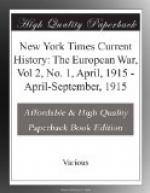On this day the artillery of the Fourth Division, Third Corps, was used in support of the attack, under orders of the General Officer Commanding Second Corps.
The remainder of the Third Corps made demonstrations against the enemy with a view to preventing him from detaching troops to the area of operations of the Second Corps.
From Dec. 15 to 17 the offensive operations which were commenced on the 14th were continued, but were confined chiefly to artillery bombardment.
The infantry advance against Wytschaete Wood was not practicable until the French on our left could make some progress to afford protection to that flank.
On the 17th it was agreed that the plan of attack as arranged should be modified; but I was requested to continue demonstrations along my line in order to assist and support certain French operations which were being conducted elsewhere.
4. In his desire to act with energy up to his instructions to demonstrate and occupy the enemy, the General Officer Commanding the Indian Corps decided to take the advantage of what appeared to him a favorable opportunity to launch attacks against the advanced trenches in his front on Dec. 18 and 19.
The attack of the Meerut Division on the left was made on the morning of the 19th with energy and determination, and was at first attended with considerable success, the enemy’s advanced trenches being captured. Later on, however, a counter-attack drove them back to their original position with considerable loss.
The attack of the Lahore Division commenced at 4:30 A.M. It was carried out by two companies each of the First Highland Light Infantry and the First Battalion, Fourth Gurkha Rifles of the Sirhind Brigade, under Lieut. Col. R.W.H. Ronaldson. This attack was completely successful, two lines of the enemy’s trenches being captured with little loss.
Before daylight the captured trenches were filled with as many men as they could hold. The front was very restricted, communication to the rear impossible.
At daybreak it was found that the position was practically untenable. Both flanks were in the air, and a supporting attack, which was late in starting, and, therefore, conducted during daylight, failed, although attempted with the greatest gallantry and resolution.
Lieut. Col. Ronaldson held on till dusk, when the whole of the captured trenches had to be evacuated, and the detachment fell back to its original line.
By the night of Dec. 19 nearly all the ground gained during the day had been lost.
From daylight on Dec. 20 the enemy commenced a heavy fire from artillery and trench mortars on the whole front of the Indian Corps. This was followed by infantry attacks, which were in especial force against Givenchy, and between that place and La Quinque Rue.
At about 10 A.M. the enemy succeeded in driving back the Sirhind Brigade and capturing a considerable part of Givenchy, but the Fifty-seventh Rifles and Ninth Bhopals, north of the canal, and the Connaught Rangers, south of it, stood firm.




